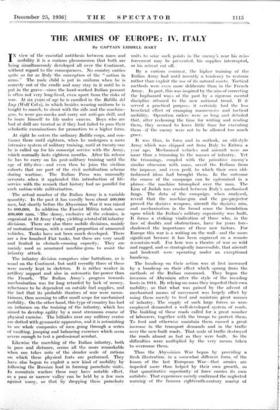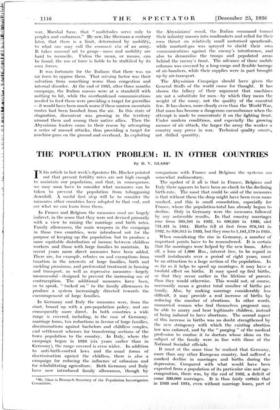THE ARMIES OF EUROPE: IV. ITALY By CAPTAIN LIDDELL HART
At eight he enters the ordinary Balilla corps, and con- tinues there until eighteen, when he undergoes a more intensive system of military training, until at twenty-one he is called. up for his conscript service with the Army, which normally. lasts eighteen months. After his release he has to carry on his post-military training until the age of fifty-five--and even then he joins the civilian cohorts that are part of the civil mobilisation scheme during wartime. The Italian Press- was unusually accurate when it applauded this introduction of life- serviee with, the remark that history had no parallel for such nation-wide militarisation.
- The actual Tiumber of the Italian Army is a variable quantity. In the past it has usu.slly been about 400,000 men, but, shortly belbre the Abyssinian War it was raised to 600,000. In-addition the Fascist Militia totals some 400,000 men. bfflhe iiirmy, exclusive of the colonies, is organised in 13 Army-Corps, yielding a total of 31 infantry divisions. • There are also three mobile divisions, mainly of motorised troops, with 'a -small proportion of armoured vehicles. Tanks have not been much developed. There are a few hundred Fiat -tanks, but-these are very 'small and limited in obstacle-crossing capacity. . They are mainly used as armoured machine-guns to assist the infantry- attack.
The infantry division comprises nine battalions, as is usual on the Continent, but until recently three of these were merely kept in skeleton. It is rather weaker in artillery support And also in automatic fire-power than the - French.' • 'The Italian Army's progress towards mechaintation was for long retarded by lack of money, reluctance to be dependent on outside fuel supplies; and the' fact that its probable theatres Of war were moun- tainous, thus seeming to offer small scope for mechanised mobility. --On the other hand, this type of country has had an influence On the training of the infantry,. which has aimed- to develop agility by a most strenuous course of physical exercise. The hillsides near any military centre arc dotted with gymnastic apparatus, and it is astonishing to see 'whole •companies of, men going through a series of vaulting, 'jumping and balancing exercises which seem severe .ennUgh to test a professional acrobat.
Likewise -the marching 'Of the Italian infantry, both in pace and distance, seems all the more remarkable when one takes note Of the slender scale of rations on which. these physical feats are performed. They have also begun to exploit a new kind of mobility by following the 'Russian lead in forming parachute units. In mountain warfare these may have notable effect, as a pasi r' narrow valley -eau- be held by 'a few men . . , . .. , against many, so that by dropping these parachute units to seize such points in the enemy's rear his rein- forcement may be prevented, his supplies interrupted, or his retreat cut off.
By a curious contrast, the higher training of the Italian Army had until recently a tendency to restrain rather than exploit the use of its natural assets. Tactical methods were even more deliberate than in the French Army. In part, this was inspired by the aim of correcting the haphazard ways of the past by a rigorous mental discipline attuned to the new national trend. If it served a practical purpose, it certainly had the less beneficial effect of cramping manoeuvres and tactical mobility. Operation orders were so long and detailed that, after reckoning the time for writing and reading them, they seemed to leave little time for executing them—if the enemy were not to be allowed too much grace.
It was thus, in form and in outlook, an old-style Army which was shipped out from Italy to Eritrea a year ago. Mechanised vehicles and aircraft were no more than a trimming to the masses of infantry. Yet the trimmings, coupled with the primitive enemy's similar obsession with mass, saved the Italians from the impasse, and even peril, to which their own . old- fashioned ideas had brought them. In the outcome the course of the campaign can be epitomised in a phrase—the machine triumphed over the man. The Lion of Judah was crushed between Italy's mechanised, fangs. The data of the campaign, when analysed, reveal that the machine-gun and the gas-projector proved the decisive weapons, aircraft thc decisive. arm, and mechanisation in the broad sense the foundation upon which the Italian's military superiority was built. It forms a striking vindication of those who, in the face of. doubts and obstructions, have for years fore- shadowed the importance of these new factors. For Europe this war is a writing on the wall—and the more significant because it has been engraved. on a remote mountain-wall. For here was a theatre of war so wild and rugged, and so strategically inaccessible, that aircraft and landcraft were operating under an exceptional handicap.
The handicap on their action was at first increased by a handicap on their effect which sprang from the methods of the- Italian command. They began the invasion of Abyssinia after 'the style of the invading hosts in 1914. By-relying on mass they impeded their own mobility; so that what was gained by the advent of mechanised Means of movement was largely offset by using them merely to feed and maintain great .masses of -infantry. The supply of such large forces as , were employed demanded a well-developed system of roads. The -building of these roads called for a great number of labourers, together with the troops to protect them. To feed and otherwise maintain them caused a great increase in • the transport demands and in the traffic over the. new-built roads.- That scale of traffic destroyed the -roads almost as fast as they were built. So the difficulties - were multiplied by the very means taken to -overcome them. -- Thus the Abyssinian War 'began by providing a fresh- illuAration, in a somewhat different form, of the lesson of the Mgt -European War—that armies are itripeded" More 'than helped by their own growth, so that quantitative superiority of force carries its own antidote. That experience merely confirmed the neglected warning- of the famous eighteenth-century Inastcr of war, Marshal Saxe, that "multitudes serve only to perplex and embarrass." He saw, like Sherman a century later, that there is a limit, determined by mobility, to what one may call the economic size of an army. It takes unusual art to gauge—mass and mobility are hard to reconcile. Unless the mean, or means, can be found, the use of force is liable to be stultified by its own forces.
It was fortunate for the Italians that there was no air force to oppose them. That mizsing factor was their salvation from something worse than congestion and internal disorder. At the end of 1935, after three months campaign, the Italian masses were at a standstill with nothing to hit, while the overburdened -communications needed to feed them were providing a target for guerrillas —it would have been much worse if these narrow mountain routes had been bombed from the air. In this state of stagnation, discontent was growing in the territory around them and among their native allies. Then the Abyssinian leaders came to their rescue by attempting a series of massed attacks, thus providing a target for machine-guns on the ground and overhead. In exploiting the Abyssinians' recoil, the Italian command turned their infantry masses into roadmakers and relied for their own thrust on relatively small motorised spearheads, while Mustard-gas was sprayed to shield their own communications against the enemy's interference, and also to Aleinoralise the • troops and Populated areas behind the enemy's front. The advance of these Mobile columns was covered by a long-range and flexible barrage air-bombers, while their supplies were in part brought up by air-transport.
The Abyssinian Campaign should have given the General Staffs of the world cause for thought. It has shown the fallacy of their argument that machines are not a substitute for men—by which they mean the weight of the many, Oot the quality, of the essential few. It has shown, more clearly even than the 'World War, that mass has become a dangerous encumbrance when the attempt is made to concentrate it on the fighting front. Under modern conditiOns, and especially the growing menace of air attack, the larger the army the weaker a country may prove in war. Technical quality counts, not drilled quantity.



































 Previous page
Previous page